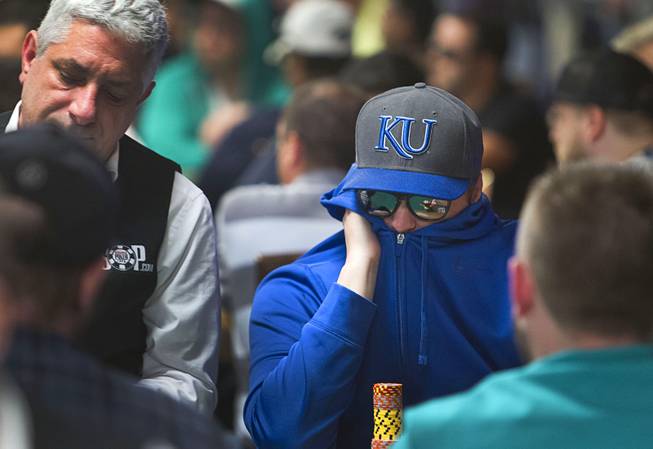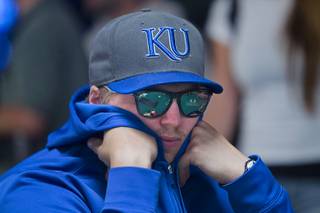
Las Vegas Sun reporter Case Keefer competes in the $565 buy-in “Colossus” event during the World Series of Poker at the Rio Monday, June 1, 2015.
Sunday, June 7, 2015 | 2 a.m.
More Coverage
The most common question I was asked after I began having a modicum of success playing poker always surprised me:
“Have you ever thought about turning pro?”
My answer is a firm no, and not because I don’t think it’s possible to eke out a modest living playing cards as a full-time job. Not entirely, at least.
The biggest reason I could never envision making a seat at the poker table my office were the inexorable swings. The possibility of being “on the job” one day, doing everything exactly right and still losing hundreds or thousands of dollars because of the workplace hazard known as variance wasn’t something I could imagine stomaching.
The mental anguish and stress level of poker is too much. Nothing could have reinforced my position better than a successful run last week through the biggest tournament in the history of poker.
There were 22,373 entries in the Colossus, the World Series of Poker’s first-ever $565 buy-in event, which was my debut on poker’s largest stage. Round up, and I finished in the top 1 percent at 300th place for $6,331 — the second-largest cash winning of my career and my biggest in a live setting.
The experience was fun in a way that a cycling hobbyist might find riding through a stage of the Tour de France — equal parts rewarding and exhausting.
I advanced to the third day of action, and after each of the first two, it felt as if someone had implanted an electronic shuffling machine into my head to rearrange the insides. I was so poker-absorbed and absent-minded, I was the final player inside the hallowed Amazon Room after Day 1 — only because I realized upon reaching the parking lot that I had left my backpack underneath my chair.
After the second night, I somehow misplaced the pink slip with the next day’s seat assignment that’s required at the start of play. Thus, a floor man had to verify my identity before I was allowed to sit down.
While trying to sleep during the 12 hours between sessions, I flopped around more than a deck of cards being washed by a dealer.
Relaxation was unattainable, with replays of hands for which I made questionable decisions from the previous day and potential strategies for the next round splashing through my mind.
Let’s just say I uncovered a new respect for the throngs of players who arrive in Las Vegas for two months annually for the World Series of Poker. I’ve covered the top players in the world for years and decided my best bet in the Colossus would be to emulate some of their practices.
Instead of supplementing my intermediate knowledge with concepts such as implied odds and game theory in the lead-up to the tournament, I reflected on some of the subtler aspects.
I remembered how two of the biggest winners I ever wrote about — Martin Jacobson in last year’s Main Event and Antonio Esfandiari in 2012’s inaugural $1 million buy-in Big One For One Drop — espoused healthy living as the key to success. From the moment I registered two days before the tournament, I maintained quite possibly the cleanest diet of my life and fit in some type of physical activity every day before sitting at the table for 10 hours.
I remembered how a few years ago, life coaches were as much a staple as sponsor patches at major final tables, with players praising the positivity they instilled. Every day before I took my seat, I scoured my iPod for hardcore songs championing a positive attitude while leaving time to calm myself with visualizations of my short-term tournament goals.
Memories of lessons from the pros hit me during play, too. When my chip stack dwindled to less than the price of 10 big blinds minutes before the money bubble, I practically was obligated to go all-in with my next decent starting hand.
I found ace-jack and pushed my chips forward but knew I was in trouble when an opponent snap-called without going through the typical poker-player act of agonizing over the decision. He revealed ace-king, making me more than a 3-to-1 underdog.
But right then, I oddly recollected a passage from one of 1995 Main Event champion Dan Harrington’s essential poker books. Harrington deduced that every deep tournament run must feature a player coming back from the dead at least once.
I paired my jack on the flop to win the pot. The double-up precipitated a heater (a winning streak, for you novices) that peaked when I picked up pocket aces to oust a shrewd pro who was so thoroughly in my head, I resorted to wearing sunglasses at the table for the first time ever. He gave me a congratulatory nod as he departed, which was much preferable to the reaction of the loser in the aforementioned hand.
The guy with ace-king, presumably as an intimidation tactic, stared me down for several minutes after surrendering his chips and derisively referred to me as “Ace Jack” for the rest of our time playing together.
I figured he was a cinch for worst sport I’d encounter, but the next day a middle-aged man in a neon-green tank top provided stiff competition. He went into a tirade about sending me home upset in a cab after I forced him into a decision for all of his chips.
I survived long enough to witness his demise but joined him outside the tournament area less than an hour later.
With my chip stack dwindling, I called an opening minimum-raise with pocket 8s. The flop fell a relatively safe 9-7-2. The raiser put out another small wager and began softly trembling as I mulled my options. I interpreted his bet sizing and demeanor as weakness, particularly since he had folded at the first sign of resistance in a previous hand after acting identically.
Not having enough chips to justify a smaller re-raise, I opted to shove all-in. He went into deep thought for several minutes before announcing a call, showing pocket 10s that held up to win.
The hand effectively eliminated me, which brought me to face another common question: How are you going to spend your payout?
As much as I’d love to repeat three-time Main Event champion Stu Ungar’s famous “gamble it” reply, that would be insincere. Professional poker isn’t in the cards for me.
Case Keefer can be reached at 702-948-2790 or [email protected]. Follow Case on Twitter at twitter.com/casekeefer.


Join the Discussion:
Check this out for a full explanation of our conversion to the LiveFyre commenting system and instructions on how to sign up for an account.
Full comments policy